Let me tell you about a scenario that’s all too common: a marketing team at a growing brand receives a $300,000 marketing budget for the year. Excited by such a large sum, the team quickly invests the money into flashy social media marketing and uber-luxurious events. And, in just a few months, their marketing funds run out.
This scenario is why you need a marketing budget ASAP. This article will cover marketing budgets in detail. You’ll learn:
- What a marketing budget is
- What a marketing budget includes
- How to create a marketing budget you can stick to
- Four formulas you can use to predict your marketing budget accurately
What Is A Marketing Budget & Why Do I Need One?
A marketing budget is the total amount of money you have to spend on your marketing strategy.
A marketing budget plan is a detailed document that outlines where you will invest your marketing funds, along with the who, what, why, and how of each expected expense. Your marketing budget plan is part of your marketing plan.
Marketing Budget Plan
A detailed document that outlines where you will invest your marketing funds, along with the who, what, why, and how of each expected expense.
In the complicated marketing landscape of today, a cohesive marketing budget plan is a must if you want to stay on budget for the year. Without one, it’s easy to lose sight of where your funds are going and run out just when you need an influx of cash for a new project.
Developing a marketing budget plan will also help you:
- Allocate funds for projects months in advance
- Prove the value of your marketing projects to company executives
- Provide reasoning for your allotted budget for next year
- Hire freelancers and staff to bring your ideas to life
- Justify why specific projects are worth investing in
- Compare your progress year-on-year
- Calculate your Marketing Return on Investment (MROI)
- Invest in the right projects

Now that you know what a marketing budget is and why you need one, here’s how to calculate how much you need in your annual marketing budget.
Identify Your Marketing Goals
First, you need to identify your marketing goals for the year. Doing so will help you estimate the types of expenses you will incur.
Be specific with your goals. Every marketing department aims to “boost revenue” and “increase sales,” for example, and these goals don’t give you much direction. How will you boost revenue? What strategies will you use to increase sales?
Here is a short list of possible goals to get you inspired:
- Increase organic website traffic with content marketing
- Improve social media Click-Throughs with a dedicated Instagram strategy
- Expand your email list to consumers in the U.K.
- Increase the number of free trial users with Paid-Per-Click (PPC) ads
Once you have a small list of 3-5 goals, prioritize them. You may need to sacrifice one goal so you can afford to reach another, so know in advance which goals are “musts” and which are “nice to haves.”
Estimate Your Monthly Marketing Operational Costs
Next, you’ll need to estimate your monthly marketing operational costs. These costs are all the basic things you need to pay for to keep the marketing department running. These expenses include the cost of marketing tools, website hosting services, marketing team member salaries, and paid WordPress themes.
Special projects like the cost of product launches or channel-specific projects don’t belong under the “operational” umbrella — we’ll account for these later.
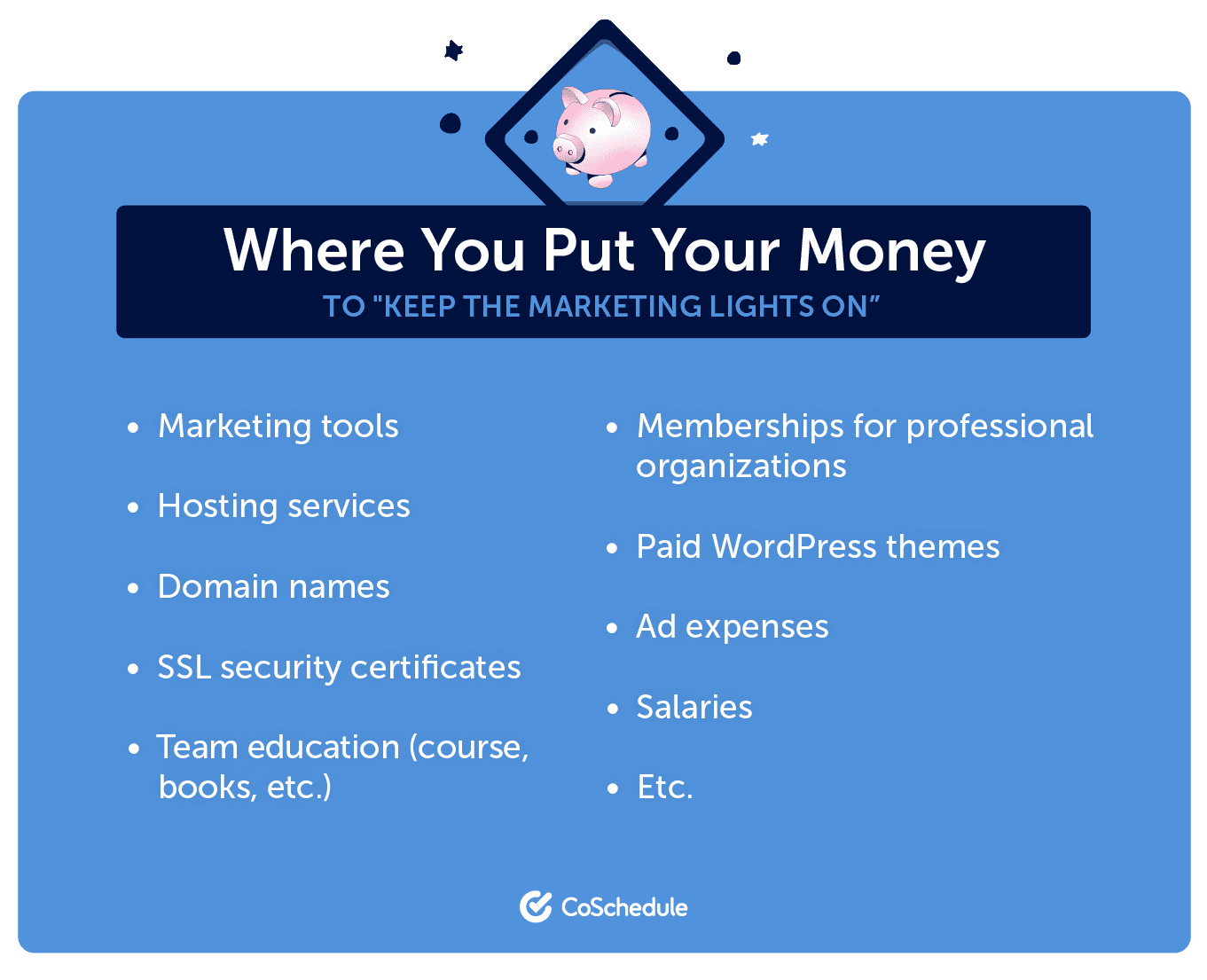
For example, let’s say that CoSchedule incurs these costs monthly:
- $8 for an SSL certificate
- $12 for domain names
- $20 for website hosting
- $150 for social listening and social media tools
- $650 for Search Engine Optimization (SEO) and content explorer tools
- $18,000 for four salaries
- $12,000 for PPC ads
In that case, CoSchedule’s monthly marketing operational cost would be $30,840. If we extrapolate this figure to 12 months, CoSchedule needs a minimum of $370,080 for marketing annually.
Determine Your Target Audience
With your basic expenses accounted for, you need to start thinking of the extra costs you’ll incur for marketing projects. You may already have a clear picture of what these projects will be (in that case, skip to “Choose Your Marketing Channels & Tactics”). Or not.
In that case, start by defining your target audience.
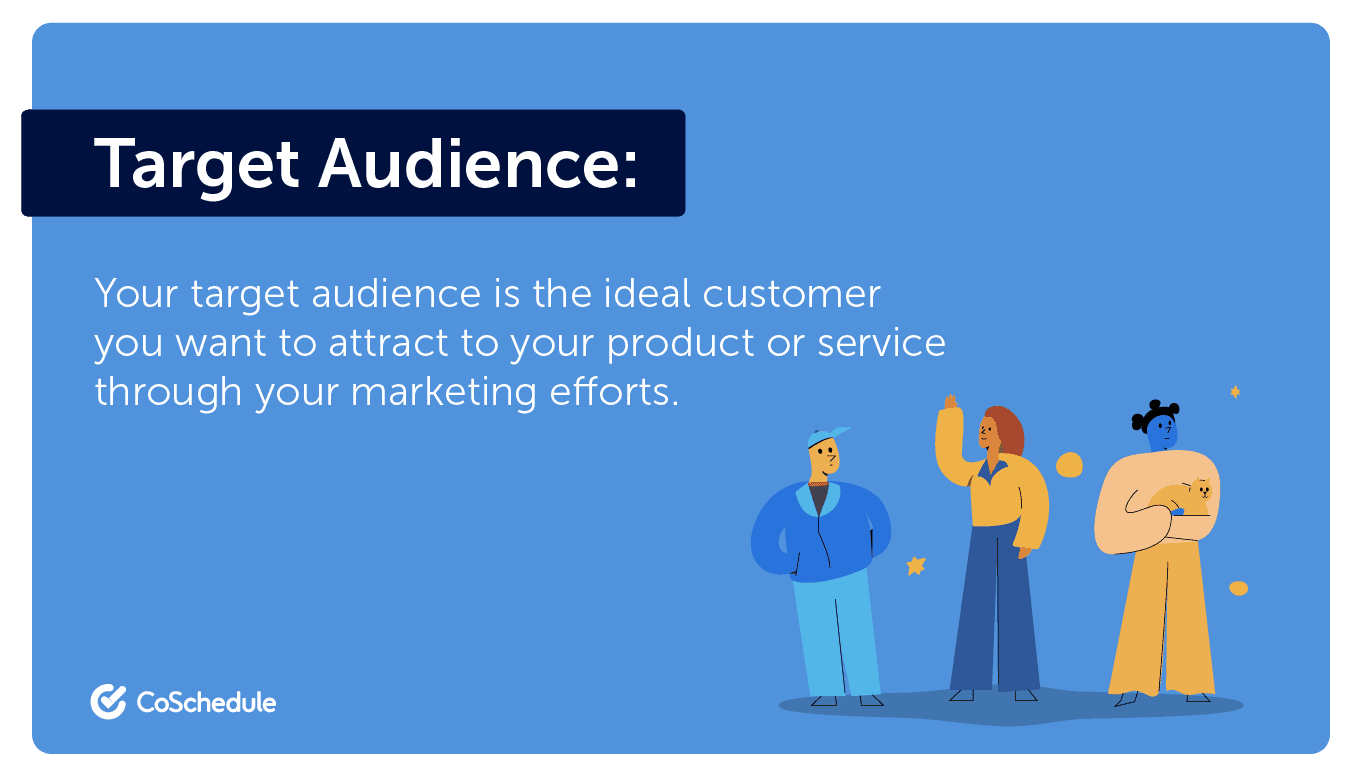
Don’t write “the general public” or “locals.” You should be specific about the characteristics of your target audience, including their age, gender, interests, pain points, motivation, experience, industry, and expectations. It might help to create a marketing persona like this one:
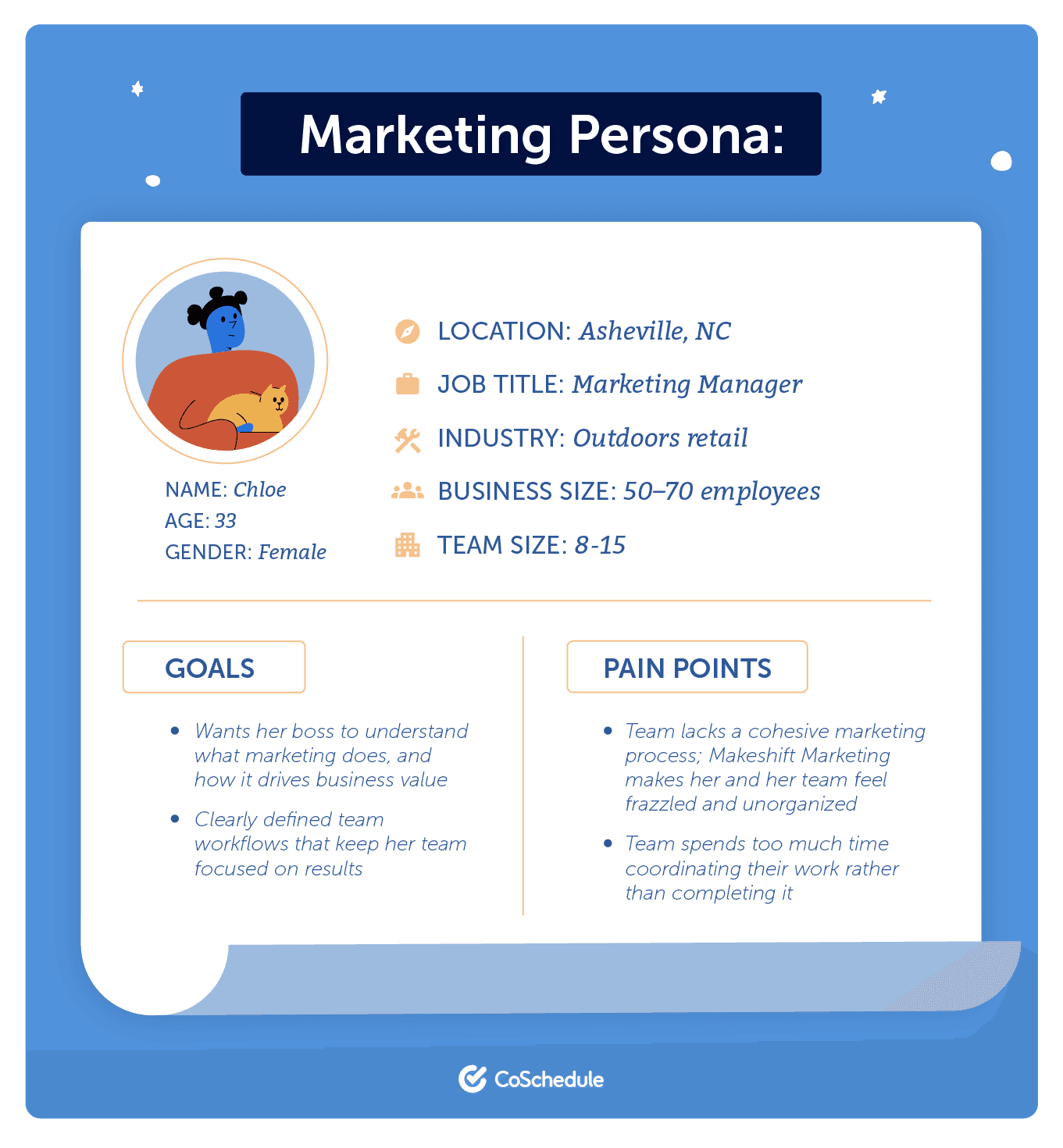
It will also help to brainstorm answers to questions like:
- Who are our most profitable customers? Who are our most unprofitable customers?
- What do customers like about our products and services?
- Why did customers choose us over the competition?
- What motivates customers to continue purchasing from us?
Research Your Competition
Now that you have a clearer picture of who your audience members are, spend some time researching how other brands market to them online.
Here are some marketing channels you should look at:
- Website marketing (including content marketing)
- Social media platforms (according to Statista, the most popular are Facebook, YouTube, WhatsApp, Instagram, WeChat, and TikTok)
- Video marketing
- PPC ads
Make sure you also analyze your competitors’ marketing. Note any tactics and messages they use, along with when and how frequently they post.
You can also use marketing models to analyze why they are successful. We recommend Porter’s 5 Forces, a SWOT analysis, an Ansoff Matrix Analysis, a PESTLE analysis, the STP Framework, and the Marketing Mix (also known as the “7 Ps of Marketing”).
Choose Your Marketing Channels & Tactics
Finally, you’ll need to select the marketing channels and marketing tactics you will use to accomplish your goals.
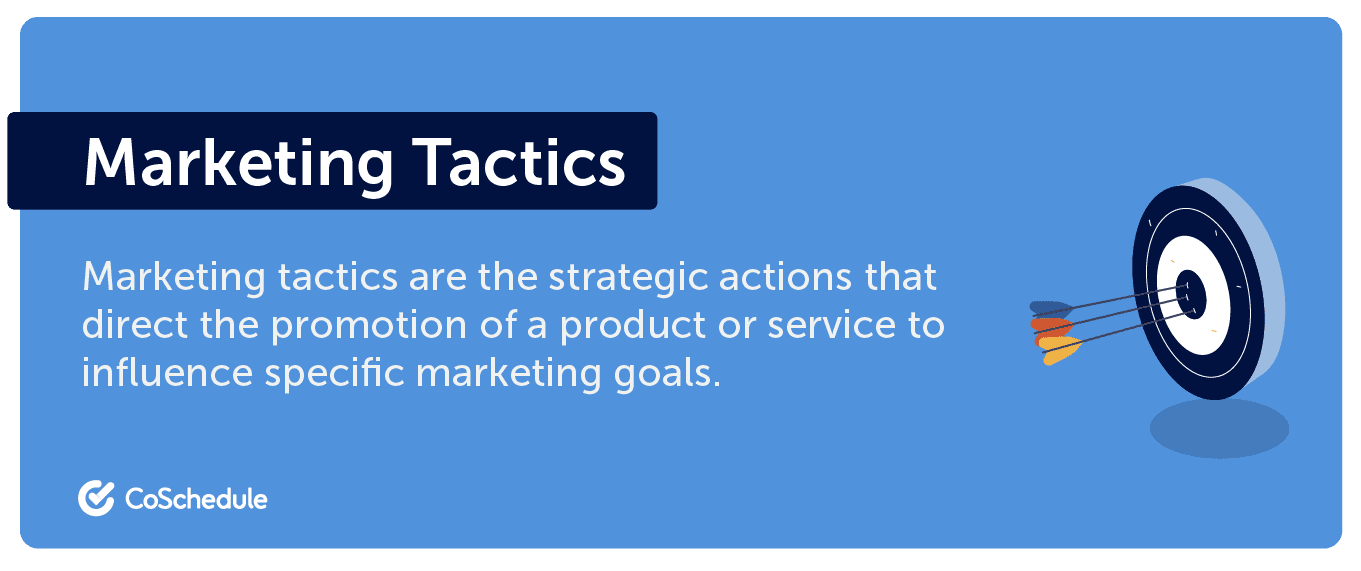
Potential options to choose from include:
- Content marketing
- Email marketing
- Social media marketing
- Influencer marketing
- SEO
- Events
- Podcasts
- Video marketing
- Affiliate marketing
- Online advertising
For each option you choose, brainstorm the potential costs you might incur. For example, for influencer marketing, you will need funds to compensate your influencers and free products for them to showcase. Or, for video marketing, you’ll need video equipment, actors, video editing software, and a filming studio.
It might help to estimate your costs over a month and extrapolate them out to 12 months.
You don’t always need an exact figure either — just estimate the cost of each channel and add 5-10% to account for any extra expenses you might incur.
Are you still struggling to nail down a clear number for your marketing budget? Here are four ways to calculate your budget and a sample marketing budget to inspire you:
Percent of Revenue
This method sees you allocating a set percentage of your overall revenue to marketing. It’s a good strategy if you don’t know the cost of individual projects and marketing channels.
Here’s the formula you need:

According to Wordstream, new businesses one to five years old should allocate 12-20% of their revenue to marketing. Older and more established businesses will have repeat business from old customers and more brand awareness, so they can get away with allocating 6-12% of their revenue to marketing.
The U.S. Small Business Administration also gives a recommended ballpark you could follow: 7-8% of your total (gross) revenue.
Top-Down
In this approach, your boss tells you how much money you have to spend, and you allocate the funds accordingly. This method isn’t particularly data-driven and doesn’t consider the business goals you’d like to meet and the projects you’re planning to take on to make those goals a reality.
Budget =
what your boss tells you the budget is
Competition-Matching
This method keeps up with the Joneses and does not foster a blue ocean marketing strategy. This method determines your budget based on the tactics your competition is executing.
For example, your competitor launches a blog. Therefore, you create a plan based on how much it will cost you to establish a blog.
Budget =
the cost of all total competitor-inspired strategies + the cost of annual operational costs
Goal-Driven
This method requires you to set goals first, then plan your budget to make the goals a reality. It involves choosing a realistic amount to help you reach your goals.
The goals-driven formula looks something like this:
Budget =
(marketing goal acquisition cost × marketing goal #) + marketing operational costs
Sample Marketing Budget
To give you an idea of what your fully-fledged marketing budget could look like, we’ve developed a sample budget for a product-based eCommerce business with four full-time staff who predominantly use content marketing, Facebook, and TikTok.
Here it is:
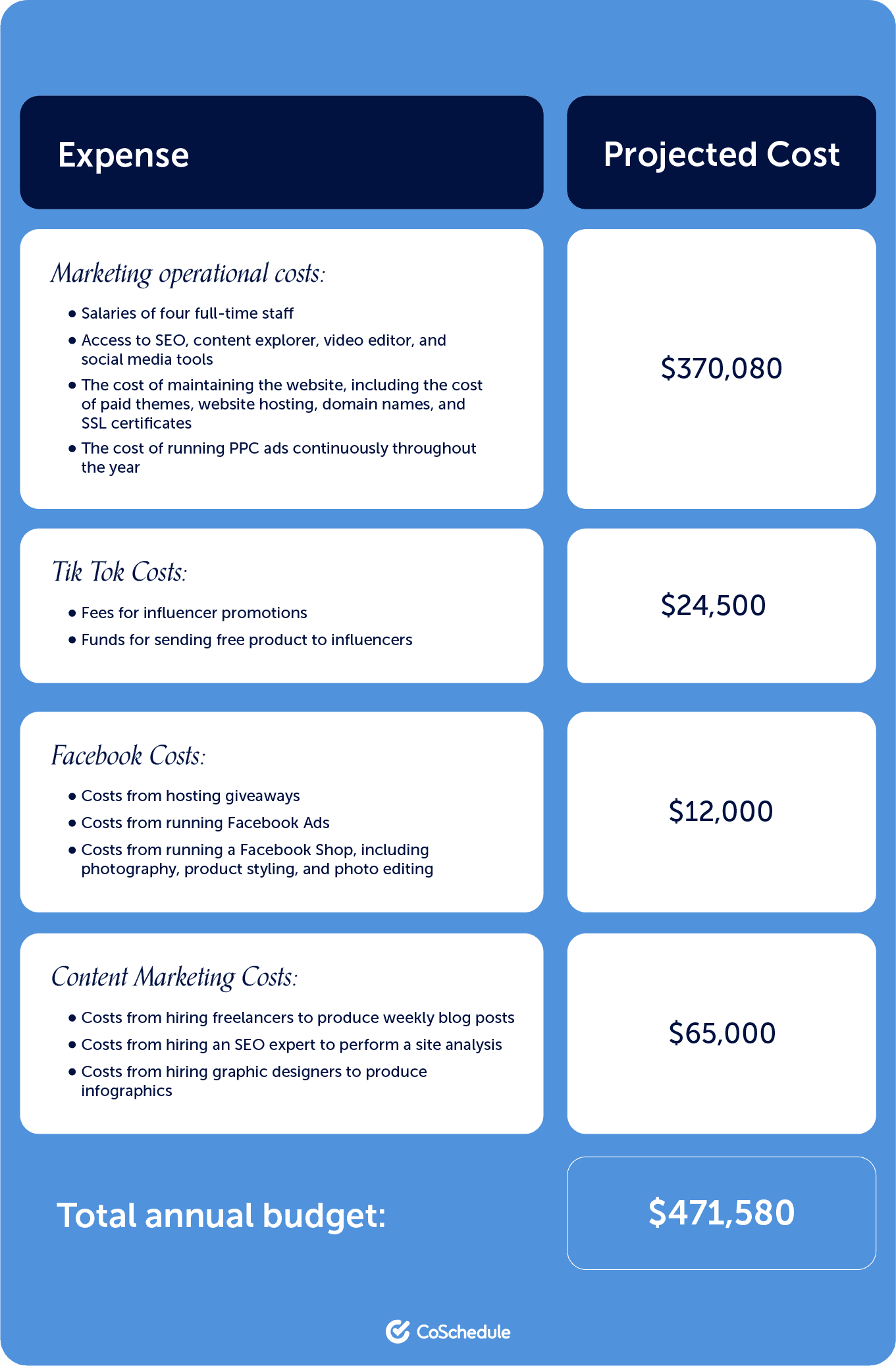
How Do You Calculate Your Marketing Budget?
To calculate how much you will need in your annual marketing budget, follow these steps:
Step 1. Identify your marketing goals and prioritize them.
Step 2. Estimate your monthly operational costs and extrapolate these costs to the entire year.
Step 3. Identify your target market.
Step 4. Research your competition so that you know what you are up against.
Step 5. Select your marketing channels, price them, and add them to your budget.
What Is A Decent Marketing Budget?
According to the U.S. Small Business Administration, you should aim to spend 7-8% of your total (gross) revenue on marketing. This amount includes the cost of advertising, producing content, and running the marketing department.
Why Is A Marketing Budget Important?
Without a budget, investing too much into one marketing project is easy. A marketing budget keeps you on track, helps you report where you invested money to higher-ups, and ensures you invest adequately in multiple marketing channels.
What Items Should Be Included In A Marketing Budget?
Your marketing budget should cover every cost needed to promote your products and services, including:
- Print advertising
- PPC advertising
- Brochures
- Exhibitions
- Events
- Social media marketing (including organic posts)
- Content marketing
- Graphic design
- Product packaging
- Public relations
- Giveaways
- Operational costs

